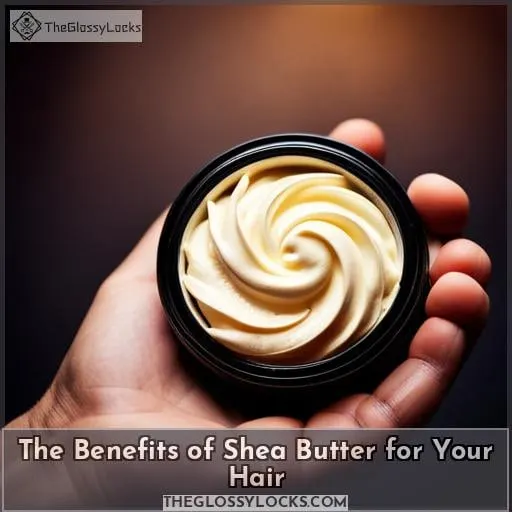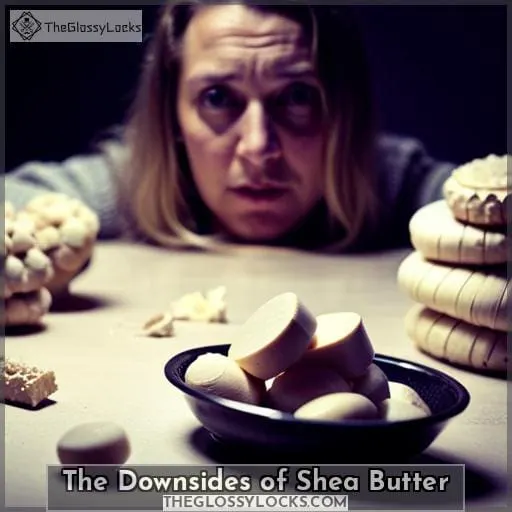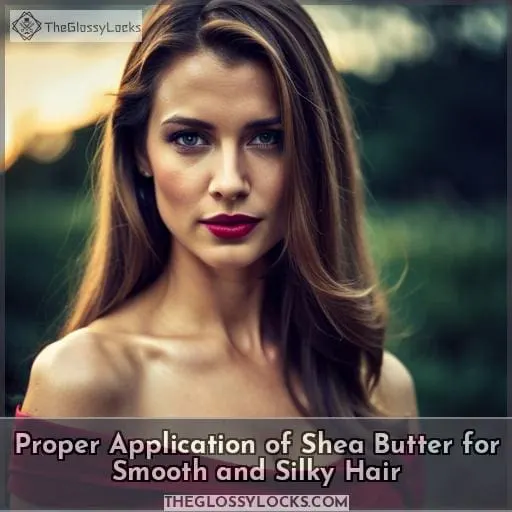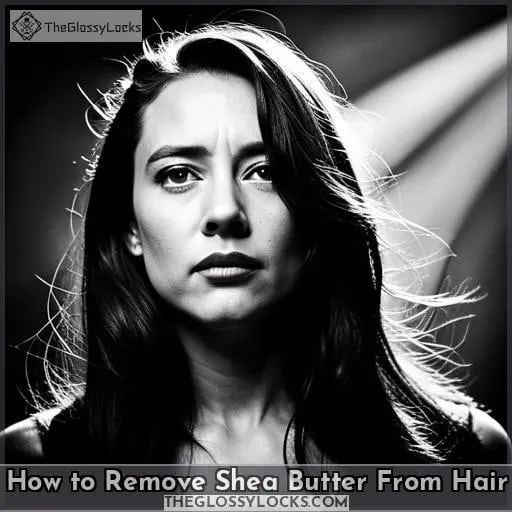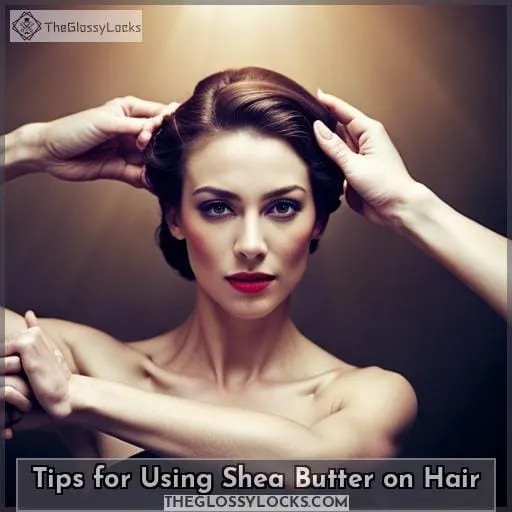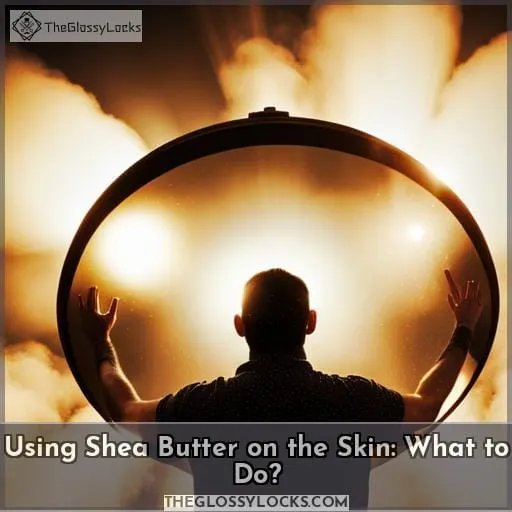This site is supported by our readers. We may earn a commission, at no cost to you, if you purchase through links.
Are you looking for ways to remove shea butter from your hair? Shea butter is a popular natural ingredient known for its moisturizing and nourishing properties. However, it can be difficult to effectively rid your hair of the product if not done in the right manner.
In this article, we will discuss how to properly apply and ultimately remove shea butter from your locks while reaping its benefits at the same time. We’ll also go over tips on why it’s best used on wet hair as well as any potential allergic reactions that may occur when using this oil-based product.
So stay tuned and get ready to learn all about removing shea butter from your mane!
Table Of Contents
- Key Takeaways
- What is Shea Butter?
- The Benefits of Shea Butter for Your Hair
- The Downsides of Shea Butter
- Proper Application of Shea Butter for Smooth and Silky Hair
- How to Remove Shea Butter From Hair
- Tips for Using Shea Butter on Hair
- Why Doesn’t Shea Butter Wash Off Easily With Soap and Water?
- Using Shea Butter on the Skin: What to Do?
- Frequently Asked Questions (FAQs)
- Conclusion
Key Takeaways
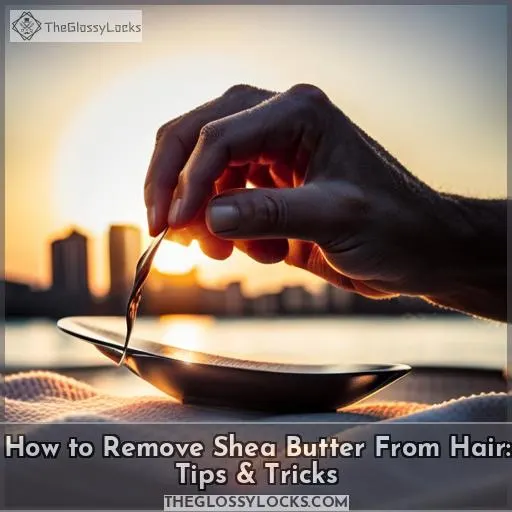
- Shea butter is difficult to remove from hair and does not easily dissolve in water.
- Coconut oil can be applied before shampooing and conditioning to help remove shea butter from hair.
- Different hair types may have varying levels of success in removing shea butter.
- Hydrogenated castor oil can be used to remove stubborn remnants of shea butter from hair.
What is Shea Butter?
You’re in luck! Shea butter is a natural product with amazing benefits for your hair, including moisturizing deeply and promoting growth. It comes from the seed of the African Shea Tree. The production process involves grinding, roasting, and boiling fat-rich kernels to make an edible oil that can be used for skin or hair care.
Unrefined shea butter is best known as a deep moisturizer since it contains vitamins A, E, and F, which condition the scalp. It also offers anti-inflammatory properties that help reduce any inflammation you may have on your scalp caused by other products or styling methods.
Shea butter also makes a great styling aid because, when applied properly (avoid direct application to the scalp), it helps create softness without leaving behind residue like many other commercialized products do.
However, due to its thick consistency, shea butter can take some time to get rinsed off completely. So, if you’re looking into using shea butter often, prepare yourself with hydrogenated castor oil, which will help remove any excess build-up quickly after shampooing twice, followed by conditioning thoroughly afterwards.
Lastly, remember those porosity issues: too much use of this product over time could lead to greasier strands, so moderation is key here!
The Benefits of Shea Butter for Your Hair
Greetings! Are you interested in learning about the incredible benefits of shea butter for your hair? Shea butter is an amazing natural product that can be used as a moisturizer, conditioner, and anti-inflammatory to help promote healthy hair growth while preventing breakage.
Not only that, but it also adds softness and shine during styling. Understanding how to use it properly will unlock its full potential for beautiful locks.
Moisturizer
You can reap the benefits of shea butter’s moisturizing power by simply applying it to damp hair and leaving it on for at least an hour before rinsing. It’s packed with natural vitamins, including A, E, and F, that help nourish your scalp while providing a great styling aid without residue.
Hydrogenated castor oil can assist in removing any build-up after shampooing twice and conditioning thoroughly with cold water or apple cider vinegar. Keep in mind that using this product too much over time could make your strands greasier than normal.
Hair Conditioner
Shea butter can make your hair soft, silky, and smooth when used as a leave-in conditioner. It provides deep conditioning and natural moisturizing benefits for healthy ends without greasiness. For optimal results, use it on wet hair with a mixture of shea butter oil and olive oil to provide a protein treatment along with heat protection.
Anti-Inflammatory Properties
With its anti-inflammatory properties, shea butter can help reduce scalp inflammation and promote healthier hair growth.
Benefits:
- Inflammation Relief
- Scalp Health
- Hair Texture
- Hair Hydration
- Product Selection
- Medical Advice
Raw Shea Butter is one of the best products to use since it contains natural ingredients that are known for their anti-inflammatory benefits. When applied to an inflamed scalp, raw shea butter helps soothe irritation and fight off any bacteria or fungi that may be affecting it.
With proper product selection, as well as medical advice when necessary, shea butter’s most notable abilities will have you seeing results in no time!
Hair Growth and Breakage Prevention
By using shea butter, you can help promote healthier hair growth and prevent breakage. Its moisturizing effects condition the scalp, allowing natural ingredients to penetrate deep into strands for maximum nourishment.
Rich in vitamins A, E, and F along with other minerals from the shea butter tree, this product is ideal for damage control. It strengthens hair fibers while maintaining a healthy balance of hydration. Shea Butter’s most notable abilities also include its ability to reduce inflammation on the scalp that may be caused by various factors such as pollution or over-styling.
With its natural properties coupled with mango butter’s added benefit of offering additional antioxidants and fatty acids, this combination will leave your locks feeling softer than ever before!
Hair Styling and Conditioning
You can use shea butter to style and condition your hair, giving it a softer, smoother texture. Its natural properties provide heat protection while helping strengthen the strands and adding shine. Shea butter’s moisturizing effects also help rejuvenate dull locks by creating new cell development for optimal health.
To remove shea butter from your hair without damaging it, follow this guide: apply a fair amount of hydrogenated castor oil to the scalp and massage it gently before shampooing with Time Body Butter’s recipe or another gentle cleanser.
The Downsides of Shea Butter
While shea butter can be an incredibly beneficial product for your hair, it is important to understand the potential downsides of using it. It can be challenging to remove from the hair as it does not dissolve easily in water and may lead to increased porosity and greasiness over time.
Additionally, some people have allergic reactions when using shea butter on their scalp or skin. Consequently, understanding how best to use this powerful product will help you reap its rewards without experiencing any negative side effects.
Challenging to Remove
Though it provides amazing benefits for your hair, shea butter can be as slippery as an eel to remove from strands. It is not water-soluble and requires a strong emulsifier when compared with Coconut Oil in cold weather areas.
For those who are allergic or experience scalp irritation, a full disclaimer policy should be adhered to before using this natural product. Over time, the use of Shea Butter may result in greasier hair due to its increased porosity but proper application can help avoid such issues.
To ensure all remaining water is removed after use, apply hydrogenated castor oil and massage onto the scalp, followed by shampooing and conditioning thoroughly.
Increased Hair Porosity and Greasiness
Over time, the use of shea butter may lead to higher porosity in your hair, ultimately resulting in greasier locks. Porosity solutions include proper application and removal techniques, such as using hydrogenated castor oil or apple cider vinegar for cleansing.
If you experience allergic reactions when using body butter on dry hair, it’s best to avoid its use altogether.
With fat-rich kernels from the Shea Tree providing amazing benefits for your tresses, follow these easy steps to ensure long weeks without greasy strands:
- Cleanse with warm water or ACV.
- Apply an emulsifier if necessary.
- Shampoo and condition thoroughly after use.
- Remove all remaining water with hydrogenated castor oil before styling!
Allergic Reactions
Be aware that some people may experience an allergic reaction when using shea butter on their hair, so be sure to do a patch test first!
Allergy symptoms can range from redness and itching to swelling and difficulty breathing. To reduce the chances of adverse side effects, take time selecting products with natural ingredients or those specifically designed for sensitive skin types.
Be sure to read ingredient labels carefully as well since even natural remedies may contain allergens like tree nuts or bee pollen. Despite the potential reactions, Shea Butter is packed with numerous vitamins and minerals offering outstanding benefits for your tresses such as moisturizing deeply while conditioning it softer promoting growth at the same time.
For frequently asked questions related to allergies linked directly or indirectly caused by this product, consult your doctor for medical advice rather than relying solely on information found online.
Proper Application of Shea Butter for Smooth and Silky Hair
To experience the best results, you should apply shea butter to clean and damp hair in a proper manner. Shea butter is a common ingredient found in many natural beauty products due to its moisturizing benefits, ability to nourish scalp health for healthy hair growth, and promote smoother styling with better coverage.
Unrefined shea butter is said to be the most beneficial as it contains vitamins A, E & F that help soften your locks from within while also acting as an anti-inflammatory agent against scalp inflammation or irritation.
When using unrefined shea butter on your mane, however, it’s important not to apply directly onto the scalp but instead through ends of dry sections of strands only. This helps ensure that no allergic reactions occur if any existing sensitivities do arise when exposed near skin areas such as neck or forehead regions too close by.
Also, leave it on for at least one hour before rinsing off with warm water, then shampoo followed by conditioner thereafter. Doing so will allow enough time for all its notable abilities like deep conditioning and softening capabilities to take full effect.
All these steps taken together are key components necessary towards achieving smooth silky tresses after each use.
How to Remove Shea Butter From Hair
Removing shea butter from hair can be a tricky process due to its inability to dissolve easily in water. Fortunately, there are steps you can take that will help ensure successful removal without damaging the strands.
Start by applying coconut oil and massaging it into your scalp before working through ends of dry sections of hair.
After that, use shampoo and work all over the head until suds appear thoroughly throughout each strand before rinsing out with warm water using gentle motions only – no rubbing or scrubbing!
Follow up with conditioner application afterwards, then finish off in the shower where you’ll have enough space available for complete rinsing out if needed at last.
Step 1: Apply Coconut Oil
Start by applying some coconut oil to your locks for a deep conditioning treatment. Coconut oil can help increase hair porosity, reduce greasy buildup, and prevent allergic reactions. Its benefits extend further than shea butter as it is also an edible oil from the cocoa butter tree, which is native to hot, humid countries like African regions that touch water frequently.
Step 2: Use Shampoo
After conditioning your hair with coconut oil, use a good quality shampoo to gently cleanse your locks and get rid of excess oils. Different types of shampoos can help reduce the impact shea butter may have on scalp health or cause further damage.
Hair care should always take into account the unique needs of each person’s head. Consider using other natural oils in combination with shampoo for best results when removing shea butter from hair. Shea butter has many notable abilities beyond moisturizing, such as reducing inflammation and promoting growth in areas where it is applied.
Step 3: Apply Conditioner and Rinse
Once you’ve shampooed your hair, apply conditioner and rinse it off to leave your locks soft, silky, and smooth. Consider the type of conditioner that’s best suited for your hair type and texture, as well as its impact on scalp health when selecting one.
Also, take into account different rinsing techniques. You can alternate between warm water and cold water or use apple cider vinegar to help remove shea butter from the strands more easily. Shea butter can be a daunting task to get out of even the most porous hairs due to its sticky nature against other oils in our tresses! The main goal is finding an easier way without compromising quality care.
Luckily, there are numerous known methods that make this process less intimidating.
Step 4: Finish in the Shower
To complete the process, bring it into the shower with you and thoroughly rinse your hair while gently massaging your scalp. Treat each strand delicately, as if it were a silk scarf, to provide extra care.
Consider using different rinsing techniques that are suitable for various hair types and needs, such as warm water or cold water. If allergic symptoms are present, you can even try using apple cider vinegar. It is important to choose conditioners carefully, based on the specific requirements for scalp care.
Tips for Using Shea Butter on Hair
If you’re looking to use shea butter on your hair, there are a few tips and tricks worth keeping in mind. First off, it’s best to apply it onto damp hair as this will help the product absorb more easily.
Additionally, combining it with other products such as oils or conditioners can improve its effectiveness. When applying directly onto strands of hair, only target the ends for maximum hydration without weighing them down too much.
Apply on Wet Hair
For best results, apply shea butter to damp hair for maximum nourishment and conditioning. Avoid directly applying it to the scalp; instead, combine it with other products such as coconut oil or hydrogenated castor oil if necessary.
Leave it on the hair for at least an hour before rinsing off with warm water or an apple cider vinegar solution. Excessive use of shea butter can lead to greasier hair over time, so proper application is key! For optimal results, rinse thoroughly and follow up with conditioner after shampooing to remove any residue left behind from using a combination of products.
Combine With Other Hair Products
You’ll love the results when you combine shea butter with other luxurious hair products! An ideal mix for conditioning tips includes natural remedies, styling techniques, and a focus on hair care. Shea butter nourishes deeply with its vitamins A, E, and F while adding moisture to dry strands.
It also relieves scalp inflammation and is an excellent choice for those who seek softer locks without greasy buildup.
Apply Only to Hair Ends
Avoid direct application to your scalp and instead, focus the shea butter on just the ends of your hair for best results! You will still enjoy its moisturizing effects without having to worry about an allergic reaction.
Its natural product properties promote gentle removal when used as a styling aid while helping with hair growth.
- Start off small by applying it in moderation
- Massage into damp strands only
- Allow time before shampooing out
- Avoid contact with eyes
- Rinse thoroughly afterwards
Avoid Excessive Use
Sparingly Moisturizing Greasiness High Porosity Scalp Irritation
Why Doesn’t Shea Butter Wash Off Easily With Soap and Water?
Since shea butter is difficult to dissolve in water, it can be challenging to completely wash off with just soap and water. This is because the natural oils found in shea butter are much more resistant than other substances like shampoo or conditioner.
Shea butter also has a higher heat retention rate, which makes it more difficult for the product to break down when exposed to warm temperatures such as those typically used during showers or baths.
Additionally, depending on your hair type, you may experience different levels of success when attempting to remove shea butter with regular soap and water due to its varying solubility properties across various strands of hair texture.
For instance, curly-haired individuals often have trouble washing out any residual butters from their tresses, while straight-haired people find that they can rinse away most products without too much effort.
It’s worth noting that certain skin reactions may occur if left on too long, so be sure not to leave it applied for an extended period before rinsing properly! Ultimately, using hydrogenated castor oil could help speed up this process by helping loosen any stubborn remnants still stuck onto the scalp’s surface prior to the shampooing and conditioning routine – making removal easier than ever before!
Using Shea Butter on the Skin: What to Do?
Using Shea Butter on the skin can be a great way to moisturize and nourish it, but it’s important to know how to use it properly.
Depending on your individual skin type, you may need more or less of the product in order for its beneficial effects to take place. Generally speaking, those with dry or sensitive skin should start off with small amounts and gradually increase as needed.
If you have oily or combination skin types, then a more generous amount could be used without fear of over-moisturizing.
It is also wise to avoid direct application onto the scalp as this can cause allergic reactions in some people.
When applying shea butter correctly, there are countless benefits. It can protect against environmental damage while locking in moisture into your complexion, reduce puffiness, improve elasticity due to its high content of Vitamin E & F, and soothe inflammation associated with sunburns/eczema flare-ups thanks again partly to those same vitamins mentioned above!
However, because everyone’s needs are different when utilizing products like these, make sure you do proper research ahead of time before beginning usage so that no surprises occur later down the line (i.
e., potential breakouts, etc). Allergy testing prior to attempting use would also not hurt either if possible at all costs, just in case an adverse reaction occurs after contact has been made between the chosen skincare item and the person utilizing said item(s) involved simultaneously.
Being safe is better than sorry, and the mantra of once again rings true here folks!.
In short, using shea butter on one’s own personal body parts can prove highly advantageous depending on the situation given by the user, whatever circumstance might present itself along the journey taken by them alike, thereby allowing maximum coverage and protection obtained throughout the entire excursion endured thoroughly.
Frequently Asked Questions (FAQs)
How much Shea Butter should I use on my hair?
Use a small amount of shea butter on your hair, as it is highly moisturizing and can make hair greasier over time. Gently massage it into damp locks and leave it in for at least an hour before washing out with warm water or apple cider vinegar.
Is Shea Butter suitable for all hair types?
Yes, shea butter is suitable for all hair types. Its vitamins and anti-inflammatory properties nourish the scalp, while its moisturizing effects make hair softer and more manageable.
How often should I use Shea Butter for optimal hair health?
For optimal hair health, use Shea Butter two to three times a week. Take care not to apply it directly to the scalp. Leave it on for at least an hour before rinsing with warm water or apple cider vinegar for best results.
Regularly using this natural moisturizer can help your hair remain soft and smooth while promoting growth and reducing inflammation of the scalp.
Are there any health risks associated with Shea Butter?
Yes, there are health risks associated with Shea Butter. Allergic reactions can occur when it is applied directly to the scalp or skin. Overuse may lead to greasy hair and increased porosity. It’s important to properly apply Shea Butter with clean, damp hair, leaving it on for at least an hour before rinsing off thoroughly.
Does Shea Butter help with dandruff?
Shea butter can provide relief from dandruff, acting like a lighthouse guiding away the stormy seas. It is rich in vitamins and has anti-inflammatory properties, helping to reduce scalp inflammation while deeply moisturizing to condition hair for smoothness and softness.
Conclusion
In conclusion, Shea butter is an effective natural product for moisturizing and conditioning the hair. It’s important to apply it properly and not use excessive amounts to avoid greasiness and buildup.
To remove Shea butter, it is recommended to use a combination of oils and shampoos. It should be applied to the hair, not directly to the scalp, to avoid allergic reactions. For a smooth and silky finish, Shea butter should be applied to wet hair and left in for at least an hour before rinsing.
All in all, Shea butter is a beneficial product that can provide great results when used correctly.


